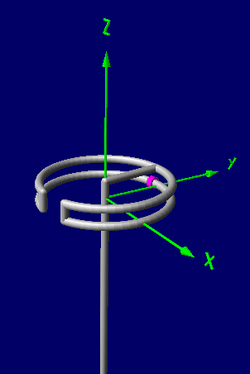Halo antenna
A halo antenna, or halo, is a horizontally polarized, omnidirectional 1⁄2 wavelength dipole antenna, which has been bent into a loop with a small break in the loop on the side directly opposite the feed point. The dipole ends are close but do not meet, and may have an air capacitor between them as needed to establish resonance.



Halo antennas vs. other loop antennas
This section compares older and more recent halo antenna designs; compares halos to large loops that are twice their size; and compares halos to small loops, which tend to be around half the size of halos built for the same frequency.
Modern vs. original halo designs
Early halo antennas[1] used two or more parallel loops, modeled after a 1943 patent[2] which was a folded dipole[3] bent into a circle.
The two loop design broadens the SWR bandwidth and helps with impedance matching. More recent halo antennas have tended to use a single conductor fed with a gamma match.[lower-alpha 1] The newer approach uses less material and reduces wind load, but may be less mechanically robust, more narrow-banded, and requires a balun to prevent feed-line radiation.
Halo vs. large loops
A halo antenna is distinct from a full-wave loop, which is double its size or larger, whose element is a complete loop, with no breaks. Further, full-wave loops produce their highest radiation perpendicular to the loop (Z-axis, in the diagram) and almost no radiation in the plane of the loop. Unlike full-wave loops, halo antennas' greatest radiation is in the plane of the loop; halos do not produce much radiation perpendicular to the plane of the loop, but do produce some.
Halo vs. small loops
A halo antenna is distinct from the small-loop antenna in size,[lower-alpha 2] radiation pattern, and radiation resistance, or efficiency. Halos are customarily operated with the plane of the loop oriented horizontally, parallel to the ground, whereas small-loop antennas often are oriented vertically. A small-loop antenna designed for transmitting is usually about half the size of a halo built for the same frequency – 1⁄4 wave in circumference, or a bit smaller. A small-loop can be at most a little less than 1⁄3 wave in circumference, or 2⁄3 of the size of a halo, and becomes increasingly difficult to tune as it approaches that maximum.
The current profile of a small loop is uniform or very nearly so, whereas the current on the halo antenna is sinusoidal. Almost all of the current in a halo antenna is on the side opposite the break in the loop, which is usually also the loop's feed-point. The part of the halo near the split has high voltages, but carries essentially no current and produces no radiation. The part opposite that gap is the part that radiates, and tends to radiate slightly more towards the split in the loop. Because a 1⁄4 wave small loop has the essentially the same current flowing in the entire loop it radiates in the plane of the loop uniformly, with no preferred direction in that plane.
Small loops’ radiation pattern is the opposite of large loops: They produce their greatest radiation in the plane of the loop, and none in the perpendicular direction, whereas halo antennas do produce some. Halo antennas’ radiation pattern, like their size, falls inbetween large and small loops, although somewhat closer to small loops.
Size is relative
Since antenna size is measured in multiples of wavelengths, a halo antenna with sufficient capacitance to operate at half its design frequency will function as a small loop; likewise, a small loop fed with a signal at approximately double its maximum design frequency will function as a halo antenna, if its reactance can be tuned low enough to resonate, or the excess reactance removed by a matching unit.
In that sense – even though built to deal with different practical constraints – the two types of loop antenna are nearly identical. The only two issues are
- how well the loop + impedance matching system + radio can accommodate the reactance at a frequency the antenna was not designed for
- whether the capacitance across the halo’s gap (there is always some) is enough to allow a near-continuous current around the loop at below-design frequencies.
Advantages and disadvantages of a halo antennas
Like all antenna designs, the halo antenna is a compromise that sacrifices one desirable quality for another even more desirable quality – for example halos are small and efficient, but only for a single frequency and a narrow band around it. The following sections discuss the advantages and disadvantages of halo antennas both for practical and theoretical issues.
Advantages
- Halo antennas have lower voltages across their gaps than small-loop antennas fed with the same power, reducing problems with arcing and electric shock.
- Halo antennas radiate more efficiently than small loops.
- On the VHF bands and above, the physical diameter of a halo is small enough to be effectively used as a mobile antenna.
- Towards the horizon, the pattern is omnidirectional to within 3 dB or less, and that can be evened out by making the loop slightly smaller and adding more capacitance between the element tips. Not only will that even out the gain, it will reduce the largely-wasted upward radiation.[lower-alpha 3]
- The radiating element of the halo is grounded, which tends to reduce static buildup (an advantage shared by other antennas fed with a gamma match).
- Halos may be stacked for additional gain. This reduces the high angle radiation, but has little or no effect on the shape of the radiation pattern in the plane of the antenna.[lower-alpha 3]
- A correctly constructed halo will present a good match to 50 Ohm coaxial cable with a low SWR.[4]
- Halos pick up less ignition noise from vehicles when mounted atop vehicle roofs than whip antennas.[5]
Disadvantages
- Radiation from horizontal halos has almost no vertical component. One can expect 3–20 dB of signal loss when working with stations using vertical polarization.[5]
- The halo antenna is structurally rigid; if attached to a vehicle, it may suffer damage from tree branches or other obstacles.
- A halo antenna can function as designed – as a resonant half-wave antenna – only at one frequency, limiting its use to a single band, or only a part of one band. A small transmitting loop can be re-tuned to a range of frequencies typically wider than 2:1, approaching 3:1, which can cover two or three different amateur bands.
- For mobile use, the halo is rather conspicuous compared to the much more common vertical whip antenna, and may attract unwanted attention.
- A halo antenna is not as efficient for distance contacts via skywave as a horizontal small loop, other things being equal, since more of its signal is sent upward instead of outward, wasting signal power “warming the clouds”.
Notes
- The gamma match is only a typical feature of modern halos; it is not essential. There are other, less common methods of feeding halos that work just as well, or better.
- Note carefully that for all antenna types, for pattern and performance measurement antenna size is measured as a fraction (or multiple) of the length of waves passing through it; hence any one antenna’s effective “size” changes depending on the frequency the attached radio is operating on.
- High angle radiation is not useful for VHF communications, except for signalling fast-orbiting spacecraft with a fixed antenna, where a radiation pattern that uniformly covers the entire sky is convenient.
References
- Stites, Francis H. (October 1947). "A Halo for Six Meters". QST Magazine, p. 24.
- US patent 2324462, Leeds, L.M. & Scheldorf, M.W., "High frequency antenna system", issued 1943-07-13, assigned to General Electric Company
- "Folded Dipole". Antenna Theory.
- Danzer, Paul (Sep 2004). "A 6 meter halo". QST Magazine. pp. 37–39.
- Tildon, Edward P. (Dec 1956). "Polarization effects in VHF mobile". QST Magazine. pp. 11–13.
External links
- "Construct a halo antenna for two meters". kr1st.com.
- "Another two meter VHF loop design". fedler.com.